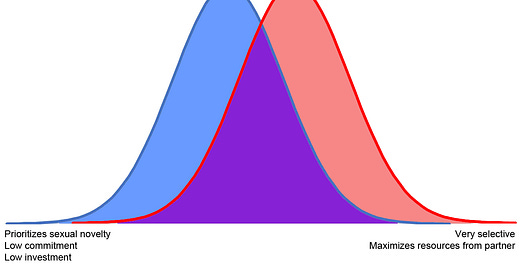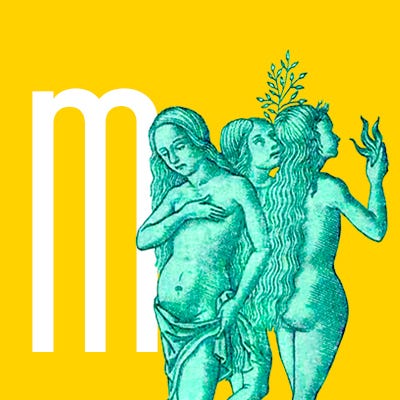Most couples just can't be happy
An evolutionary perspective on the debate between reactionary feminists and common sense feminists
I have closely followed the recent discussion between reactionary feminists and a group that could be called common sense feminists. The reactionary feminists, notably Mary Harrington and Louise Perry, hold the superficially unintuitive position that the sexual revolution and efficient contraceptives did not free women as intended. The common sense feminists contradict them and say that it is obvious that sexual freedom and contraceptives benefit women. And they are both right. When Louise Perry says that the sexual revolution worsened the situation for women in some situations, she is right. When Stella Tsantekidou says that her mother and her friends are not very happy in their traditional lifestyles, she is most probably also right.
Both sides are right, for a simple reason: For humans, being together is really, really hard. There are many different ways of being unhappy together. Many people were genuinely unhappy together in the system before the sexual revolution. Many people are genuinely unhappy now.
Men and women are natural enemies. Not-all-men and not-all-women. In any given moment, a certain share of the population forms happy couples. But how many? 30 percent? 50 percent? 70 percent? That depends on definitions. What is clear is that no system for human relationships has yet allowed the vast majority of people to be happy together.
There are two reasons to believe that this state of imperfection is caused by human nature.
Some people are better at relationships than others. In every system, a certain share of the population will fail to form happy relationships because they are just innately bad at building close relationships in general.
Men and women have evolved different mating strategies. Some of those mating strategies are cooperative. Others are exploitative. There is a good reason to assume that only men and women with not-too-sex-typical mating strategies can get along peacefully.
Male and female mating strategies differ on average. They also overlap. A bit like this:
There obviously are men whose mating strategies are too male to allow them to live a harmonious family life with more or less any woman: Men who appreciate sexual novelty too much and are not interested in investing in their children can't become good husbands and fathers. It is less obvious, but uncooperative strategies doubtlessly have evolved on the female side too. Just as some males are programmed to shirk on paternal duties, some females are programmed to deceive their male partners in order to get a maximum amount of resources for their current and future children. Those women are probably as bad partners as the men who won't settle.
Society can never make those two curves overlap completely. What it can do, is to make them overlap more or less. People's mating strategies are affected both by their innate psychological disposition and what society tells them is feasible. If society encourages men and women to meet in the middle ground, more people will do so. If society encourages people to be true to their own feelings and inner dispositions, the divide between men and women is likely to increase. If people are not even trying to get along, fewer will. Then the curves will look more like this:
I think this is what we are seeing right now. In our current hyper-individualistic society, people are supposed to be true to their feelings when choosing mating strategies. So many high-status men are honest about wanting to have several sexual partners. On the other side, many women are honest that they only want a partner who can truly meet their needs. Both sexes have pulled away in their respective directions and the middle ground where they can meet has shrunk.
How to maximize happiness?
From the reasoning above, it looks like the system of yesterday was better. More men and women could be together and people tend to become happier together. But there is an obvious counterargument: What if most families were unhappy yesterday? Even unhappier than most people are now?
Ideally, a mating system should serve people in every possible situation. It should:
a. Produce children and raise them well. The more, the better. Otherwise the system is bound to disappear within a few generations.
b. Maximize the incentives for men and women to choose a mating strategy in the middle ground where they can meet.
c. Make matches as accurate as possible. Avoid as much as possible that people who are not compatible have children together.
d. Minimize the number of miserable people. Also if happy marriage is the foremost road to true happiness, people who can't, or don't want to reach that goal should be as happy as possible.
These points are all desirable. And they stand in opposition to each other in a complex array. c stands in opposition to a and b. The more picky people become, the higher the chance they marry the right person and avoid the wrong person. The more picky people become, the higher the risk that they will never form families at all. d stands in a certain degree of opposition to a and b. Whenever the rights of people who do not form families are advocated, incentives to form families decrease a bit.
A world of trade-offs
Every aspect of human mating contains such trade-offs. Most notably, whenever norms for divorce are eased, two things will happen:
More people in unhappy marriages will break free.
The incentives for getting along will decrease.
If people don't get second chances to divorce and remarry, some of them will be caught in nightmarish situations. Many of them will also invest all they have in their current relationship, knowing that there are no more chances. The Amish are one such example. They ban divorce completely. Unless their former spouse is dead, they are forbidden from remarrying. No exceptions. Such a rule definitely causes deep unhappiness for numerous individuals. It also very likely causes high levels of male investment in children. Amish men are forbidden to practice serial monogamy, which many higher-status men in the majority population do. When Amish people get married, most often in their early twenties, they know that their current partner is very likely to be the only partner they will ever have.
The mating game is filled with such trade-offs. The upcoming feminist debate is about which side of the trade-off is the most important. How much weight should be given to people feeling bad in relationships? How much weight should be given to people who are involuntarily single? How much weight should be given to the interests of children? It is a matter of taste.
Reactionary feminism has done the feminist discussion a great favor through highlighting that all women do not have the same interests. No matter how much we debate exactly how many women have casual sex out of free will and how many have casual sex because the system pressures them to. The basic fact remains: There will always be some women who earnestly love to have casual sex and some who earnestly want to condition sex with investment. The different interests of those two groups somehow need to be balanced, just as other opposing interests in society.
“Women” is not an interest group. It is a biological category. The sooner we can talk about the fact that different women have different interests, the better. One does not need to be a reactionary to appreciate that.
Edit 19 April: Apple Pie has written a post called Most Couples are Happy, contra the headline of this post. He is right - the headline is factually incorrect. In the current US, most couples actually are happy.
Substacks referenced above:








I think this is an overly simplistic view of mating strategies.
High value, high status men might seem like the ones with a low commitment / sexual novelty strategy, but they are also very selective when it comes to what partner are they are eventually going to commit to. I have experienced it myself - I was not a high status man, but learning pickup skills put me in a high value man mindset. I was very selective, eventually met an exceptional woman and we are happily married now. One of the things that makes me feel happy in this relationship is how I didn't have to settle for anything, I married just the person I wanted. But I also know that my previous experiences with women have made me aware of what I really wanted and allowed me to choose wisely.
What makes high status men highly selective is their realistic perspective of having casual relationships, which is better than a mediocre committed relationship but worse than an amazing relationship with an exceptional woman.
Walt Bismarck has an interesting description of how apparently this happens on the female side as well (see here: https://newaltright.substack.com/p/stop-being-mean-to-slutty-women) - he writes about how liberal, promiscuous women use that strategy to get their foot in the door with high value men and then, once in a committed relationship, turn into tradwives.
To sum up, novelty seeking / low commitment and selectiveness go hand in hand - if you're selective, you got to have a large enough pool of available mates to select from.
Also, these strategies work on individual level, but would probably not scale on the society. On social level, the main concern in developed countries is fertility, and we should fix the system to allow for more people entering committed relationships and having children together, even if this makes the society less happy on average. Otherwise the Western society and culture will perish in a few generations.
"Men and women are natural enemies."
_
This is terrifyingly wrong.